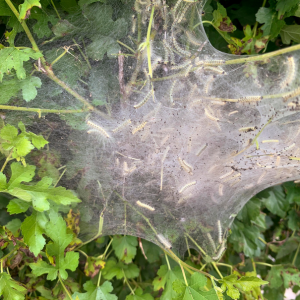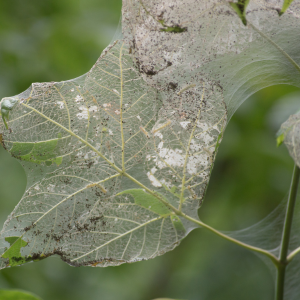Fall webworms usually begin to emerge throughout Maryland and Northern Virginia in July. They are called “fall” webworms because generally people start noticing them when leaves fall from trees and homeowners then notice their webs.
As the fall season approaches, we want to make sure you know how to identify a fall webworm, understand their activity, and answer common questions about fall webworms.
411 on Fall Webworms
What Do Fall Webworms Look Like?
Fall webworms (Hyphantria cunea) are caterpillars that undergo a transformational lifecycle. These caterpillars are about 1 inch in length, covered in fine white or light yellow hair, and they often display a range of black or red markings. Their appearance can vary, but the most striking feature is their web-enclosed nests, which are often found in the crooks of tree branches.
Fall webworm activity does look similar to tent caterpillars, however they emerge in the spring.
What Are Some Signs of Webworm Activity?
One of the most conspicuous signs of fall webworm activity is the presence of silken webs covering the tips of branches. These webs expand as the caterpillars grow and feed on foliage within the enclosure. Leaves within the webs are devoured, often leaving only the midribs behind. This can lead to a patchy, defoliated appearance in affected trees.
Fall webworms tend to be on the end of branches surrounded by leaves since they actually do not leave their web, like tent caterpillars do.

What Type of Plants Are Fall Webworms Attracted To?
Fall webworms are known to infest a wide range of deciduous trees, shrubs, and plants. They are particularly fond of hardwood trees such as walnut, hickory, oak, cherry, and mulberry. However, they can also be found on other ornamental trees like apple, pear, and plum.
Are Fall Webworms Harmful?
While fall webworms can cause defoliation and damage to trees, they are generally not considered a significant threat to the overall health of mature trees. Healthy trees can usually recover from the defoliation caused by these caterpillars, especially if the infestation is limited to a few branches. However, repeated or severe infestations over consecutive years can weaken a tree and make it more susceptible to other stressors.
What Do Fall Webworms Turn Into?
After several weeks of feeding and growing within their silken nests, fall webworm caterpillars pupate and transform into moths. These moths are white with dark spots on their wings and have a wingspan of about 1 to 1.5 inches. The adult moths emerge from their cocoons and seek out mates to reproduce, starting the cycle anew.
Do Fall Webworms Sting?
No, fall webworms are not equipped with stingers and are not harmful to humans. They might look intimidating due to their appearance and presence in trees, but they are not venomous or dangerous to touch.
How Do You Get Rid of Fall Webworms in Trees?
There are several ways to manage and get rid of fall webworms:
- Pruning: If you notice small web nests early in the season, you can prune the affected branches and destroy the nests
- Bt (Bacillus thuringiensis): This natural bacterium can be applied to your foliage. When caterpillars ingest the bacterium, it disrupts their digestive system and leads to their demise.
- Insecticidal Sprays: If infestations are severe and causing significant damage, insecticidal sprays can be used. Consult with a professional on appropriate products and application methods.
- Cultural Practices: Keeping trees healthy through regular watering, fertilization, and proper pruning can help them better withstand the effects of webworm feeding.
Fall webworms might create unsightly nests and cause defoliation, but by understanding their lifecycle, recognizing their activity, and employing effective control methods, you can strike a balance between enjoying your trees and mitigating the impact of these seasonal inhabitants.
If you want to prevent or eliminate fall webworms from your plants, click here to learn about our tree and shrub program.
